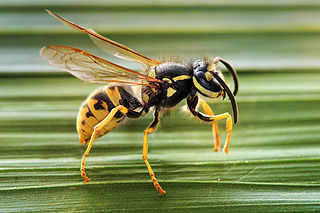
The Vespidae are a large, diverse, cosmopolitan family of wasps, including nearly all the known eusocial wasps and many solitary wasps. Each social wasp colony includes a queen and a number of female workers with varying degrees of sterility relative to the queen. In temperate social species, colonies usually last only one year, dying at the onset of winter. New queens and males (drones) are produced towards the end of the summer, and after mating, the queens hibernate over winter in cracks or other sheltered locations. The nests of most species are constructed out of mud, but polistines and vespines use plant fibers, chewed to form a sort of paper. Many species are pollen vectors contributing to the pollination of several plants, being potential or even effective pollinators, while others are notable predators of pest insect species.

Sceliphron caementarium, also known as the yellow-legged mud-dauber wasp, black-and-yellow mud dauber, or black-waisted mud-dauber, is a species of sphecid wasp. There are some 30 other species of Sceliphron that occur throughout the world, though in appearance and habits they are quite similar to S. caementarium.

Apocrita is a suborder of insects in the order Hymenoptera. It includes wasps, bees, and ants, and consists of many families. It contains the most advanced hymenopterans and is distinguished from Symphyta by the narrow "waist" (petiole) formed between the first two segments of the actual abdomen; the first abdominal segment is fused to the thorax, and is called the propodeum. Therefore, it is general practice, when discussing the body of an apocritan in a technical sense, to refer to the mesosoma and metasoma rather than the "thorax" and "abdomen", respectively. The evolution of a constricted waist was an important adaption for the parasitoid lifestyle of the ancestral apocritan, allowing more maneuverability of the female's ovipositor. The ovipositor either extends freely or is retracted, and may be developed into a stinger for both defense and paralyzing prey. Larvae are legless and blind, and either feed inside a host or in a nest cell provisioned by their mothers.

The Australian hornet, actually a type of potter wasp or "mason wasp", is a vespid insect native to the Australian states and territories of the Australian Capital Territory, New South Wales, Northern Territory, Victoria, Queensland and Western Australia.

Potter wasps, the Eumeninae, are a cosmopolitan wasp group presently treated as a subfamily of Vespidae, but sometimes recognized in the past as a separate family, Eumenidae.

The Stenogastrinae are a subfamily of social wasps included in the family Vespidae. They are sometimes called hover wasps owing to the particular hovering flight of some species. Their morphology and biology present interesting peculiarities.

Vespa tropica, the greater banded hornet, is a tropical species of hornet found in Southern Asia, New Guinea and west Africa, and which has recently been discovered to be an invasive species on the Pacific island of Guam. It is a predator of paper wasps and possesses a potent sting, which can cause extreme pain and swelling.

A wasp is any insect of the narrow-waisted suborder Apocrita of the order Hymenoptera which is neither a bee nor an ant; this excludes the broad-waisted sawflies (Symphyta), which look somewhat like wasps, but are in a separate suborder. The wasps do not constitute a clade, a complete natural group with a single ancestor, as bees and ants are deeply nested within the wasps, having evolved from wasp ancestors. Wasps that are members of the clade Aculeata can sting their prey.

Monobia quadridens, also known as the four-toothed mason wasp, is a species of solitary potter wasp found in North America. It grows to a wingspan of 18 millimetres (0.71 in), and feeds on small caterpillars and pollen. There are two generations per year, with one generation overwintering as pupae.
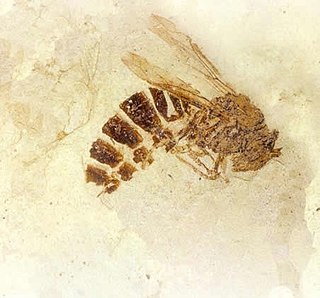
Palaeovespa is an extinct genus of wasp in the Vespidae subfamily Vespinae. The genus currently contains eight species, five from the Priabonian stage Florissant Formation in Colorado, United States two from the middle Eocene Baltic amber deposits of Europe. and one species from the late Paleocene of France.
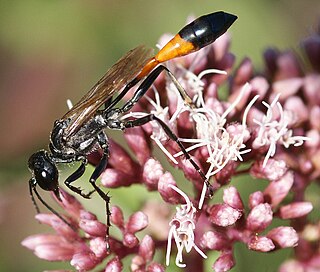
Ammophila sabulosa, the red-banded sand wasp, is a species of the subfamily Ammophilinae of the solitary hunting wasp family Sphecidae, also called digger wasps. Found across Eurasia, the parasitoid wasp is notable for the mass provisioning behaviour of the females, hunting caterpillars mainly on sunny days, paralysing them with a sting, and burying them in a burrow with a single egg. The species is also remarkable for the extent to which females parasitise their own species, either stealing prey from nests of other females to provision their own nests, or in brood parasitism, removing the other female's egg and laying one of her own instead.

Abispa splendida is a species of wasp in the Vespidae family.

Polistes carnifex, commonly known as the executioner wasp, is a neotropical vespid wasp in the cosmopolitan genus Polistes.

Eumenes fraternus is a species of potter wasp in the subfamily Eumeninae of the family Vespidae. It is native to the eastern United States and Canada. The female builds a miniature pot out of mud in which it lays an egg and places a live caterpillar. Its developing larva feeds on this whereas the adult wasp feeds primarily on nectar.
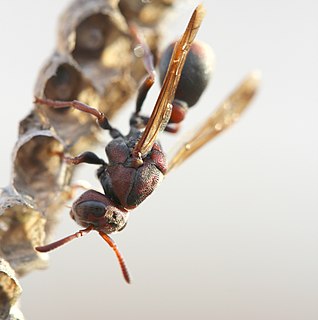
Ropalidia revolutionalis, the stick-nest brown paper wasp, is a diurnal social wasp of the family Vespidae. They are known for the distinctive combs they make for their nests, and they are mostly found in Queensland, Australia in the areas of Brisbane and Townsville. They are an independent founding wasp species, and they build new nests each spring. They can be helpful because they control insect pests in gardens.

Symmorphus allobrogus is a species of potter wasps belonging to the subfamily Eumeninae.

Pison spinolae, commonly known as mason wasp, is a solitary wasp of the family Crabronidae, found throughout New Zealand.
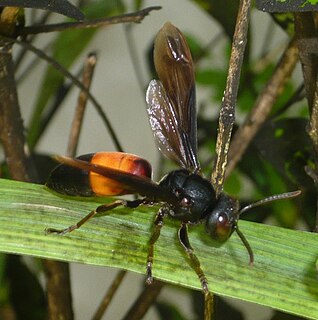
Vespa affinis, the lesser banded hornet, is a common hornet in tropical and subtropical Asia.

Sceliphron asiaticum is a species of thread-waisted wasp in the family Sphecidae. It is native to the Neotropics, South America and the Caribbean region.

Symmorphus cristatus is a species of mason wasp in the subfamily Eumeninae within the family Vespidae. This species is widely distributed in North America, and it preys on the larvae of leaf beetles.

























